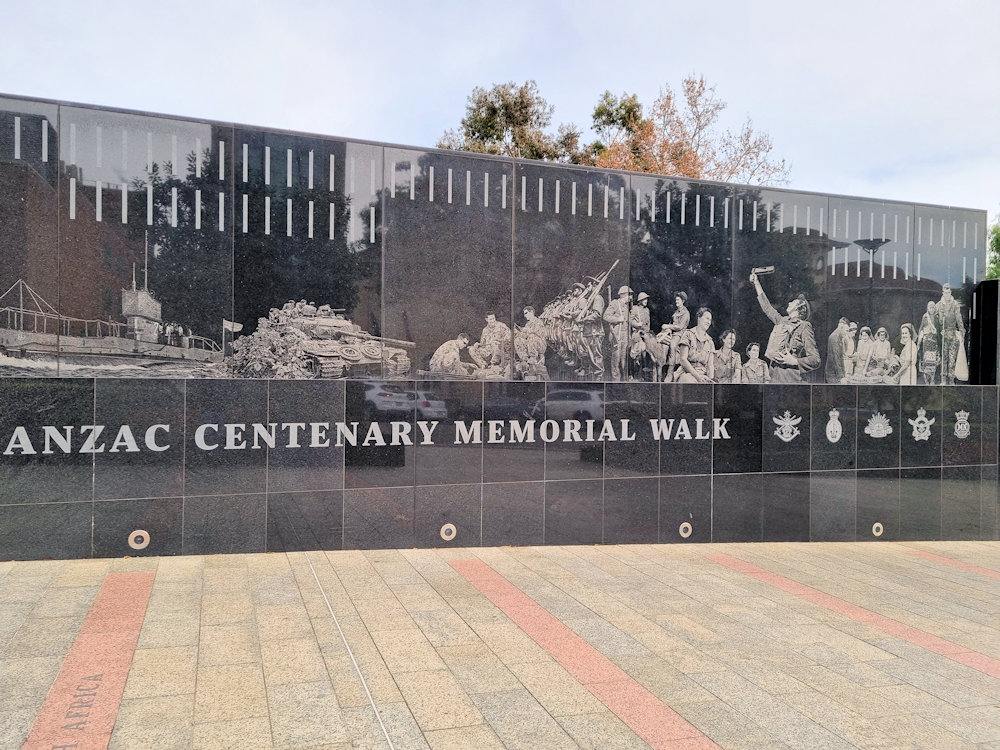ANZAC Centenary Memorial Walk Adelaide
The ANZAC Centenary Memorial Walk in Adelaide is one of South Australia’s most important commemorative projects of recent years. Built to mark the centenary of the Gallipoli landings in 1915, it honours the service of South Australians in all wars, conflicts, and peacekeeping missions. Officially opened in April 2016, the walk links the state’s cultural precinct along North Terrace with the South Australian National War Memorial on Kintore Avenue. It was conceived not only as a place of ceremony but also as a living part of the city’s streetscape — a walkway where daily life and remembrance meet.
Origins and Planning
As Australia approached the centenary of the First World War in 2014, each state considered how best to mark the milestone. In South Australia, attention turned to the National War Memorial on North Terrace, a striking interwar monument dedicated in 1931. Though architecturally impressive, the memorial stood slightly apart from Adelaide’s central cultural strip, separated by Government House grounds and Kintore Avenue.
Veterans’ groups, the Returned and Services League (RSL), and civic planners recognised an opportunity. By creating a dedicated memorial walk along Kintore Avenue, the city could provide a dignified ceremonial approach to the war memorial, while also embedding remembrance more visibly into the civic heart. The project would be South Australia’s flagship ANZAC Centenary initiative, standing as both commemoration and legacy.
Funding was secured jointly from the Commonwealth and South Australian governments, with contributions from corporate sponsors and community donors. The design commission was awarded to Grieve Gillett Andersen, a local architectural practice experienced in cultural and civic projects.
Design Philosophy
The design team approached the project with a dual ambition: to create a solemn commemorative space worthy of military service, and to ensure the space functioned as an everyday city walkway. The philosophy was not to impose a monumental structure, but to reshape the streetscape so that remembrance became a natural part of urban life.
Key Features
The Memorial Wall
The most striking feature is the black granite memorial wall running along the walk. Etched into its surface is imagery of service men and women, giving human presence to the history.

Paving Stones and Inscriptions
The wide granite-paved walkway is more than a path. Embedded within the paving are inscribed stones naming specific battles and theatres of war. As visitors walk, they trace a chronological journey through South Australia’s military history. This approach transforms the ground itself into a narrative device, allowing each step to represent remembrance.

Landscaping
Landscaped garden beds and native plantings frame the walk, softening the stone and concrete surfaces while connecting the site to the natural environment. Plant choices emphasise resilience and continuity, reflecting qualities often associated with service. The gardens also provide places for quiet reflection.
Lighting
At night, discreet lighting illuminates the wall and inscriptions. The atmosphere is contemplative without being imposing, allowing the walk to function for evening ceremonies such as vigils while remaining inviting for casual nighttime use.
Integration with Government House
Part of the project involved shifting the boundary wall of Government House and replacing sections with open blade fencing. This opened sightlines, visually connecting the memorial walk with both Government House and the National War Memorial beyond. It created a sense of civic openness and accessibility rather than separation.

Construction and Opening
Construction began in 2015, with the aim of completion before the end of the ANZAC Centenary period. The memorial walk was officially opened in April 2016 by Premier Jay Weatherill, accompanied by veterans, community representatives, and school groups. The opening was marked by a large public ceremony, reflecting the importance of the project as South Australia’s enduring centenary legacy.
Ceremonial Role
Since its opening, the memorial walk has become integral to Adelaide’s commemorative calendar. On ANZAC Day, the dawn service at the National War Memorial often sees veterans and the public passing along the walk and wreaths laid at the wall. On Remembrance Day, the space provides a gathering point for ceremonies at the eleventh hour of the eleventh day.
Other events, such as peacekeeper commemorations or youth vigils, also make use of the walk. Its design accommodates both large formal gatherings and small, personal acts of remembrance.
Everyday Role
What distinguishes the memorial walk from many older monuments is its integration into daily life. Office workers use it as a thoroughfare, students pass along it on their way to lectures, and tourists include it in walking tours of the cultural precinct. This daily use ensures that remembrance is not confined to ceremonial occasions but woven into the rhythm of the city.
Relationship to the National War Memorial
The memorial walk’s destination is the South Australian National War Memorial, one of Adelaide’s most impressive interwar monuments. Dedicated in 1931, the memorial features a tall stone pylon with bas-reliefs depicting the triumph of the spirit over the horrors of war. By linking this memorial directly to North Terrace via Kintore Avenue, the centenary walk strengthens its prominence in the city’s landscape.
Rather than being an isolated shrine, the war memorial now forms part of a connected commemorative axis, ensuring greater public visibility and accessibility. The walk thus functions as both approach and interpretation, leading the visitor from context to commemoration.

Educational Significance
Education was a central purpose of the centenary walk. The inscribed stones, etched imagery, and chronological arrangement of conflicts provide interpretive value beyond mere names. Young people encounter the breadth of South Australia’s contribution to military service, from the trenches of the Western Front to modern peacekeeping missions.
By including nurses, peacekeepers, and more recent veterans, the memorial avoids confining remembrance to the First and Second World Wars. It acknowledges the continuing story of service, making it relevant for contemporary audiences as well as those connected to earlier generations.
To find more things to see and do in South Australia, click here.

Leave a Reply